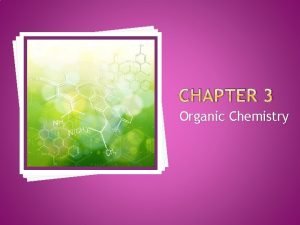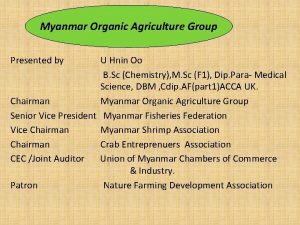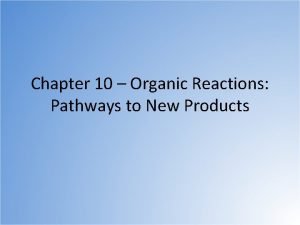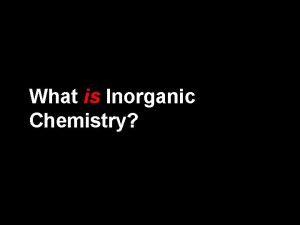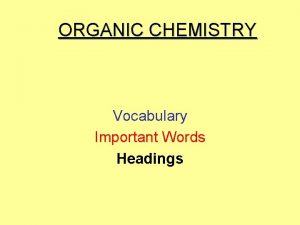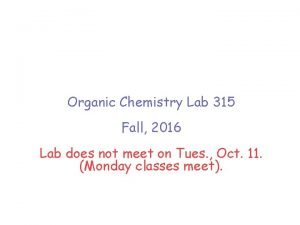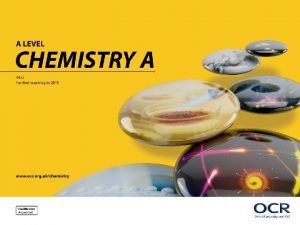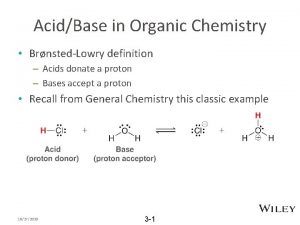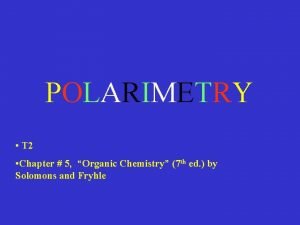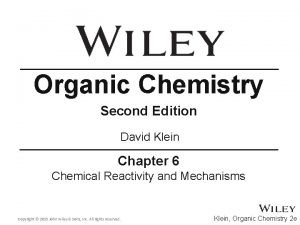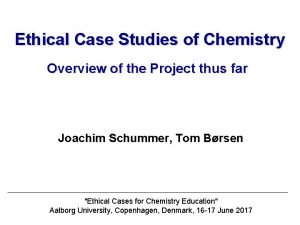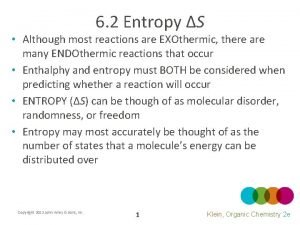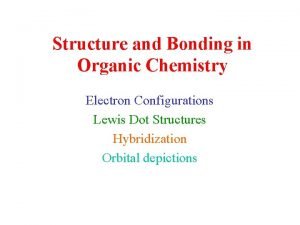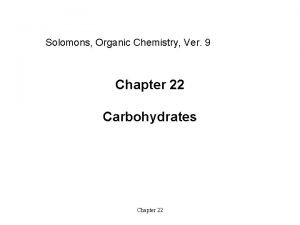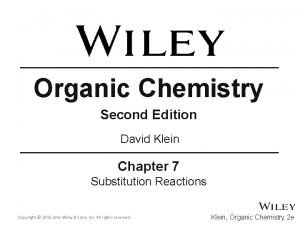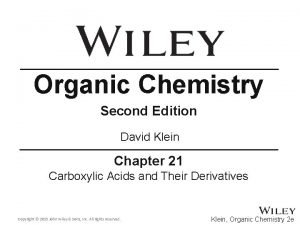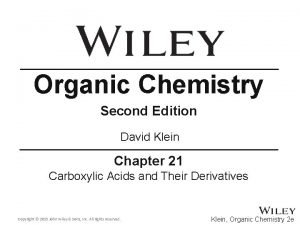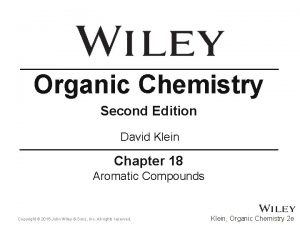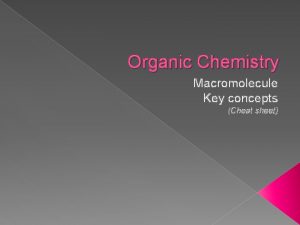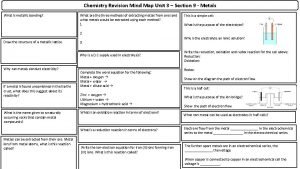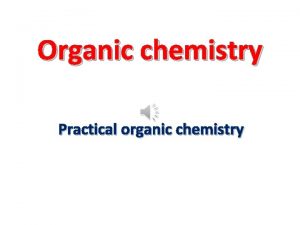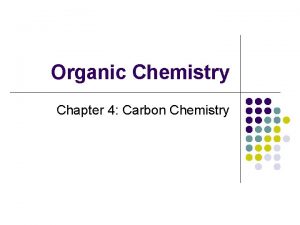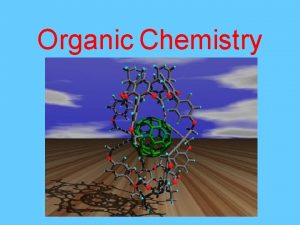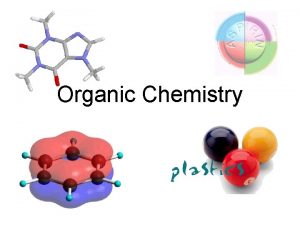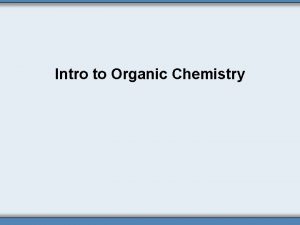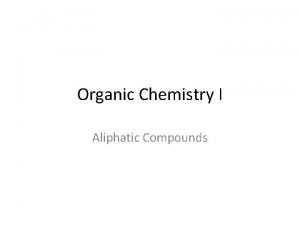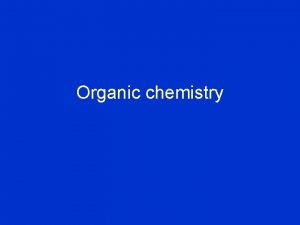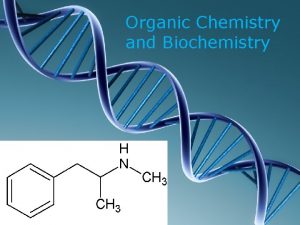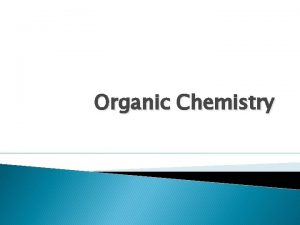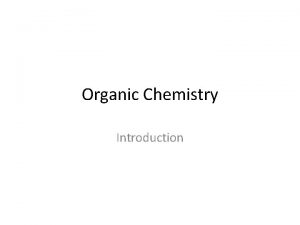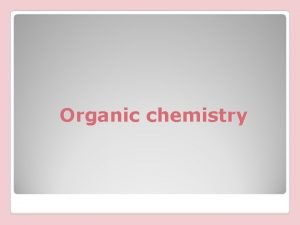CHAPTER 3 Organic Chemistry A 3 1 Organic





























































- Slides: 61

CHAPTER 3 Organic Chemistry

A 3. 1 – Organic Compounds

ORGANIC CHEMISTRY o the word “organic” means of, relating to, or derived from living organisms o organic chemistry is defined as the study of the molecular compounds of carbon § compounds containing carbon-based ions (e. g. carbonate) are not considered to be organic compounds because they contain ionic bonds

ORGANIC CHEMISTRY o of the over 10 million chemical compounds that have been discovered, at least 90% are carbon-based molecular compounds the properties of organic compounds are a result of the covalent bonds within their molecules o o recall, covalent bonds occur when the valence electrons of two non-metals are shared

CARBON AS A BUILDING BLOCK � carbon has the highest number of bonding electrons of any element � 4 bonding electrons � because of its high bonding capacity, carbon atoms have the ability to form chains, rings, spheres, sheets, and tubes of almost any size � carbon can also form single, double, and triple covalent bonds

ILLUSTRATING ORGANIC COMPOUNDS o Lewis dot diagrams are useful for the small and simple molecules… H � but are awkward with the larger, more complex molecules found in organic chemistry.

ILLUSTRATING ORGANIC COMPOUNDS o one way to speed up the process is to expand the molecular formula into clusters of carbons �e. g. CH 3 -CH 2 - etc… �to the right are six different ways of illustrating the compound C 5 H 12: 1 – the Lewis dot diagram 2 – complete structural diagram 3 – condensed structural diagram 4 – expanded molecular formula 5 – simplified structural diagram 6 – line structural diagram

CLASSIFYING ORGANIC COMPOUNDS o in order to manage the enormous number of different organic compounds, chemists divide them into families based what makes the compound special �types of bonds single, double or triple H H H H

� Functional groups �groups of atoms with elements other than carbon and hydrogen �these additional groups are responsible for the unique properties of some compound groups Ex. ethanol CH 3–CH 2 –OH, has the hydroxyl functional group (-OH) which gives the compound its physical and chemical properties, such as higher solubility, & flammability.

ALKANES o o o hydrocarbons are compounds containing only carbon and hydrogen atoms alkanes are hydrocarbons with only single carbon-to-carbon bonds the general formula for all alkanes is Cn. H 2 n+2 �as the size (and molar mass) of an alkane increases, the boiling point increases �bigger molecules will have MORE BONDS, so MORE ENERGY is needed to break them apart to change state

name ALKANES All alkane names end in – ane The prefix (beginning of the word) indicates how many carbons are in the chain o o o Ex. Meth = one cartbon, eth = two, prop= 3, etc… o notice that the first four (the smallest ones) are gases, the next twelve are liquids, it isn’t until the molecules get very large (C 17 H 36)that are big enough to be solid o o formula methane CH 4 (g) ethane C 2 H 6(g) propane C 3 H 8(g) butane C 4 H 10(g) pentane C 5 H 12(l) hexane C 6 H 14(l) heptane C 7 H 16(l) octane C 8 H 18(l) nonane C 9 H 20(l) decane C 10 H 22(l)

NAMING ALKANES: Step #1: o identify the longest continuous chain of carbon atoms ( the parent chain) in the structural diagram o Note: they may not be in a straight line, but all must be connected

NAMING ALKANES: Step #2: o number the carbon atoms in the parent chain, starting from the end closest to a branch. Name it! The number of carbons determines what the prefix is. o Only singled bonds, means it ends in –ane o o See page 9 of your data booklet for the complete list of alkanes four carbons = butane three carbons = propane

NAMING ALKANES: Step #3: o identify any branches and their location, using a number on the parent chain. o branch names always end in –yl the prefixes (meth = one carbon, eth = two, prop= 3, etc…) indicates how many carbons are in the branch o o o if the compound has more than one of the same type of branch, the number of BOTH locations is listed, and a prefix is provided one single carbon branch on the second carbon of the parent chain TWO single carbon branches BOTH on the second carbon of the parent chain = 2, 2 -dimethyl ___ = 2 -methyl___

NAMING ALKANES: Step #4: o write the complete IUPAC name, following this format: o (number of locations) – (branch name)(parent chain)

* one, two carbon branch on carbon 5 = 5 -ethyl 10 carbon parent chain = decane * four, one carbon branches on carbon 3, 4, 4 & 6 = 3, 4, 4, 6 -tetra methyl o o where there are more than one type of branch group, (some with one carbon; methyl, and others with two carbons; ethyl) the branches are named in alphabetical order (E-thyl before M-ethyl) Now put it all together… 5 -ethyl -3, 4, 4, 6 -tetra methyldecane

PRACTICE 1: o Name this compound:

PRACTICE PROBLEM #1: ANSWER o Step #1 & 2: the parent chain is identified and numbered, beginning at the end closest to the first branch. o 6 carbons = hexane o o Step #3: the first branch is identified as a single carbon branch (methyl), on C#2. o methyl on 2 = 2 methyl o _____-2 methyl_____

PRACTICE PROBLEM #1: ANSWER o Step #3 cont: a second branch is identified as a two carbon branch(ethyl) on C#3 o ethyl on 3 = 3 -ethyl o o 3 -ethyl_________ Step #4: o Put it all together! o remember, where there are more than one branch group, the branches are named in alphabetical order o (ethyl before methyl).

TO DRAW ALKANES: � to draw alkanes, use the IUPAC name, starting from the BACK of the compound name: � Ex. 3 -ethyl-2, 4 -dimethylpentane � Step #1: � identify the name of the parent chain and the corresponding number of carbon atoms: pentane = 5 carbon parent chain draw the skeleton of the parent chain

TO DRAW ALKANES: � Step #2: � identify the type of branches and position them on the appropriate carbons on the parent chain. 2, 4 -dimethyl = TWO single carbon 3 -ethyl = branches on the second and fourth carbon. ONE double carbon � Draw them in! branch on the third carbon

TO DRAW ALKANES: o Step #3: o fill-in any unfilled bond sites with hydrogens. o Don’t add too many! Remember each carbon has a MAXIMUM bonding capacity of 4!

TRY THESE! � Draw the complete structural diagram for: NOT �ethane � 4 -propyloctane � 2, 2, 4, 5 -tetramethylhexane

ASSIGNMENT: ü Practice Problems (page 110) �Q. ü 1 -4 (a & c only) 3. 1 Summary (page 121) �Q’s 4, 5 (a, c, e 7 g) & 6

ASSIGNMENT: Complete the Alkanes Worksheet You must submit your work by the end of class

A 3. 2 – Alkenes & Alkynes

ALKENES AND ALKYNES o Alkenes and alkynes are hydrocarbons with double and triple bonds o hydrocarbons with double bonds are called alkenes, and with triple bonds are called alkynes. o these compounds are named in a similar way to alkanes, (using prefixes to indicate the number of carbon atoms), but their names will end in –ene and –yne. ethyne triple bond

ALKENES AND ALKYNES name formula ethene propene butene pentene hexene heptene octene nonene decene C 2 H 4(g) C 3 H 6(g) C 4 H 8(g) C 5 H 10(l) C 6 H 12(l) C 7 H 14(l) C 8 H 16(l) C 9 H 18(l) C 10 H 20(l) ethyne propyne butyne pentyne hexyne heptyne octyne nonyne decyne C 2 H 2(g) C 3 H 4(g) C 4 H 5(g) C 5 H 8(l) C 6 H 10(l) C 7 H 12(l) C 8 H 14(l) C 9 H 16(l) C 10 H 18(l) o recall the general formula for alkanes was Cn. H 2 n+2 o the general formula for alkenes is Cn. H 2 n o and for alkynes is Cn. H 2 n-2

STABILITY OF ORGANIC COMPOUNDS � the type of bond affects the chemical properties, such as reactivity, and physical properties, such boiling point, melting point and solubility. o o a compound will be MORE STABLE if it is larger o this is because it has more carbon-carbon bonds to break during the reaction OR if it DOES NOT contain multiple bonds o alkenes and alkynes (double or triple bond) are relatively easy to break o this is because it has more hydrogen bonds are a stabilizing force in a molecule

o MORE STABLE compounds have: higher melting point/ boiling point o are less reactive o more likely to be found in solid form o

SOLUBILITY recall the phrase “like dissolves like” o o o polar solutes dissolve easily in polar solvents. water is polar, so it easily dissolves ionic compounds, acids, and polar molecular compounds �Ex. salt, hydrochloric acid or ethanol o alkanes, alkenes and alkynes are NON-POLAR, so they dissolve better in a non-polar solvent (like oil) than a polar one, such as water.

PRACTICE PROBLEM: � Rank the following compounds in order of lowest to highest boiling point �pentane, butane, propane �propene, propane, propyne � Rank the following compounds in order from least to most reactive �ethyne, nonane, pentene �octane, heptene, octene

PRACTICE PROBLEM ANSWERS: � Rank the following compounds in order of lowest to highest boiling point �pentane, butane, propane MORE STABLE if it is larger = higher boiling point…must rank smallest to largest �propane (3 C’s) butane (4 C’s) pentane (5 C’s) �propene, propane, propyne MORE STABLE if it contains ALL single bonds = higher boiling point …must rank from least to most single bonds �propyne (triple bond) (single bonds) propene (double bond) propane

PRACTICE PROBLEM ANSWERS: � Rank the following compounds in order from least to most reactive �ethyne, nonane, pentene MORE STABLE if it is larger and/or if it contains ALL single bonds = less reactive…must rank from smallest with most double/triple bonds. �nonane (largest-9 C’s & single bond) pentene (5 C’s & ethyne (smallest-2 C’s & triple bond) �octane, heptene, octene double bond) �octane (largest-8 C’s & single bond) double bond) octene (8 C’s & heptene (smallest-7 C’s & double bond)

NAMING ALKENES AND ALKYNES o Naming alkenes and alkynes is similar to naming alkanes; o using prefixes to indicate the number of carbon atoms and the ending indicates the type of bond o alkanes end in –ane o alkenes end in –ene o alkynes end in -yne Since the location of a multiple bond affects the chemical and physical properties of a compound the name of the compound must specify the location of the multiple bond o

� pent- 1 -ene indicates the double bond is located between the 1 st and 2 nd carbons of the parent chain � pent- 2 -ene indicates the double bond is located between the 2 nd and 3 rd carbons of the parent chain

NAMING ALKENES AND ALKYNES o the rules for naming are similar to alkanes, with three additional rules: �Step #1: find the longest continuous carbon chain; this is the parent chain. Use the number of carbons to determine which prefix for alkenes and alkynes the parent chain must contain the multiple bond five carbons = pentdouble bond = - ene

NAMING ALKENES AND ALKYNES 1 2 3 4 5 �Step #2: to determine the location of the double/triple bond, the parent chain is numbered bond between 2 & 3 = _____-2 - ______ for alkenes and alkynes you start numbering from the end closest to the multiple bond (not closest to the first branch as for alkanes)

NAMING ALKENES AND ALKYNES �Step #3: identify any branches and their location, using a number on the parent chain (just like with alkanes). o o count from the SAME side you started numbering the bond from branch names always end in –yl Two carbon branch on third carbon = 3 -ethyl _____

§ Step #4: o write the complete IUPAC name, following this format: o (number of locations)–(branch name)(prefix of carbon chain -location of bond- suffix of parent chain) o 3 -ethylpent-2 -ene five carbons = pentdouble bond = - ene bond between 2 & 3 Two carbon branch on third carbon

TRY THIS: � Name the following compound

PRACTICE PROBLEM (ANSWER) five carbons = penttriple bond = - eye bond between 2 & 3 identify any branches single carbon branch on fourth carbon = 4 -methyl § Put it all together

TO DRAW ALKENES/ALKYNES: to draw alkenes and alkynes, use the same rules as you did for drawing alkanes, � use the IUPAC name, starting from the BACK of the compound name: � Ex. 2, 5 -dimethylhept-3 -yne � � Step #1: � identify the name of the parent chain, the corresponding number of carbon atoms AND the type/ location of the bond 2, 5 -dimethylhept-3 -yne hept- = 7 carbon parent chain, 3 -yne is a triple bond on the third carbon

Draw the skeleton 2 1 3 4 5 6 7 � Remember the maximum bonding capacity of carbon is 4… so that will affect the number of hydrogens on some of the carbons in the parent chain. Since there are THREE bond in between the C’s and one, connecting to the rest of the chain there is NO ROOM for any hydrogens.

TO DRAW ALKENES/ ALKYNES : � Step #2: � identify the type of branches and position them on the appropriate carbons on the parent chain. 2, 5 -dimethylhept-3 -yne 2, 5 -dimethyl = TWO single carbon � Draw them in! branches on the second and fifth carbon H 3 2 1 C H H 4 H 6 5 C H H 7

TO DRAW ALKENES/ALKYNES : o Step #3: o fill-in any unfilled bond sites with hydrogens. o Don’t add too many! Remember each carbon has a MAXIMUM bonding capacity of 4! H H 2 C H H 3 4 H 5 C H H 6 H H H 1 7 H H 2 C H H 3 4 H 5 C H H H 6 7 H

ISOMERS o Isomers are compounds containing the same number of carbons and hydrogens but in different arrangements o Isomers have the same formula, but different structural diagrams. C 7 H 16 -di C 7 H 16

PRACTICE PROBLEM: � Draw the following isomers �pentane � 2 -methylbutane � 2, 2 -dimethylpropane � What is the chemical formula for each isomer?

ALKENES AND ALKYNES o if an organic compound has carbon-carbon double bonds, it is said to be unsaturated. vs. o the addition of hydrogen molecules, to an unsaturated is called hydrogenation and results in a saturated hydrocarbon o the term saturated means “full” so think of alkanes are being “full” of hydrogens, where alkenes and alkynes ARE NOT

ALKENES AND ALKYNES to become saturated, the double (or triple) bond breaks, and the hydrogen atoms take the place of the multiple bond o this reaction is called an addition reaction o H H there must always be enough hydrogens in an addition reaction to fill all the unbonded sites. o Alkynes have triple bonds so TWO hydrogen molecules (4 hydrogens) are required to fill the bonding sites +2

o alkenes and alkynes also tend to react readily with other small diatomic molecules such as the halogens o F 2 , Cl 2, Br 2 , & I 2 o Like with a hydrogen addition reaction, some of the bonding sites once occupied by multiple carbon-carbon bonds become filled with a halogen Cl Cl Cl - Cl

o The terms saturated and unsaturated are often used in combination with “fats” o o animal fats and plant oils can be a good source of energy. fatty acids (aka fats) are organic molecules made of �a long chain of carbons with a -COOH group at one end a methyl group at the other end FATS AND OILS

o Recall that the structure of a molecule affects it physical and chemical properties oils tend to be unsaturated fats—(containing double or triple bonds) o this causes the molecule to bend, which is why the molecules can pack together as tightly. o This is why they tend to be liquids at room temperature o OILS

FATS Fats (either manmade or from animals) tend to be saturated fats—(containing ONLY single bonds) o this causes the molecule to straight, so they can pack tightly together. o This is why they tend to be solids at room temperature. o Their solid sate AND the fact that they are alkanes (containing all single bonds) mean they are VERY stable o o this means they have HIGH boiling/ melting points

UNSATURATED FATS o monounsaturated fats –have one double bond (and two fewer hydrogens than a saturated fat) o polyunsaturated fats – have more than one double bond, (so even fewer hydrogens) unsaturated fats are better for the body o hydrocarbons with double or triple bonds are more reactive/easy to break down = less work for our bodies to break down o saturated fats are harder for your body to break down, so they stick around and cause “body fat”. o

ESSENTIAL FATTY ACIDS o essential fatty acids are fats your body can’t make, and are found only in certain foods �“omega-6” fatty acids are found in margarine, processed foods, corn oil and soybean oil while these fats are important for clotting and inflammation, many people eat too many omega-6 s �“omega-3” fatty acids are found in some fish, flax seeds, and enriched eggs these fats have the opposite effect as omega-6 s – they reduce swelling and slow blood clotting, so a balance between the two is important

TRANS FATS “Cis” and “Trans” refer to different 3 D arrangements of a molecule “Cis” fats are naturally occurring, but can be made into “Trans” fats through a hydrogenation o o o the addition reaction involving hydrogen.

TRANS FATS o o o Because they are synthetic, trans fats are the hardest for your body to break down, and are the worst kinds of fat. Trans fats are found in many processed foods and fast foods because � they are in solid form, so they are easier to work with than oils � they are softer and easier to spread that typical animal fats � you need less trans fats to have the same effect on a food, so they qualify for a “low fat” label, even though the fats are much worse for you Because food manufacturers are allowed to put up to 0. 5 g of trans fats in their food and still label it as “trans fat free”, be sure to check ingredients labels for partially hydrogenated oils

ASSIGNMENT: Practice Problems (pg 129) Q. 28 & 29 ** CAUTION! Your textbook uses the old IUPAC naming system, where the location of the bond goes BEFORE the parent chain. You must use the current method: Ex. A hydrocarbon with a double bond between the 1 st and 2 nd carbon: you SHOULD write hex-1 -ene, your textbook writes it as 1 -hexene ü ü Practice Problems (pg 132) Q’s 31 ü 3. 2 Summary (pg 136) Q’s 3 & 4, 8 &10

ASSIGNMENT: Complete the Try This Activity Building Models of Hydrocarbons

A 3. 3 &3. 4 - Industrial Processes Involving Organic Compounds ASSIGNMENT: ü ü Use the “Fractional Distillation” applet, to complete the Utilizing Technology: From Petroleum to Gasoline Complete the Ch 3. 4 -Everyday uses of Hydrocarbons Inquiry Questions
 Ib chemistry functional groups
Ib chemistry functional groups Inorganic vs organic chemistry
Inorganic vs organic chemistry Organic chemistry (3rd) edition chapter 1 problem 16s
Organic chemistry (3rd) edition chapter 1 problem 16s Introduction to organic chemistry
Introduction to organic chemistry Chapter 22 review organic chemistry section 1 answers
Chapter 22 review organic chemistry section 1 answers Organic chemistry third edition david klein
Organic chemistry third edition david klein Organic chemistry chapter 9
Organic chemistry chapter 9 Chapter 7 organic chemistry
Chapter 7 organic chemistry Entane
Entane Organic chemistry chapter 1 problem 59pp
Organic chemistry chapter 1 problem 59pp Halohydrin formation
Halohydrin formation Father of organic chemistry
Father of organic chemistry Chemistry of soap making
Chemistry of soap making Ester organic chemistry
Ester organic chemistry Cooh
Cooh Organic chemistry david klein 3rd edition
Organic chemistry david klein 3rd edition Ee organic chemistry
Ee organic chemistry Ario organic chemistry
Ario organic chemistry Nomenclature of ethers
Nomenclature of ethers Is alkane an organic compound
Is alkane an organic compound Leveling effect organic chemistry
Leveling effect organic chemistry Cn functional group
Cn functional group Objective lab report example
Objective lab report example Www.masterorganicchemistry.com
Www.masterorganicchemistry.com Grade 10 organic chemistry
Grade 10 organic chemistry Cyclo organic chemistry
Cyclo organic chemistry Kiliani fischer synthesis
Kiliani fischer synthesis Crash course organic chemistry
Crash course organic chemistry Alkane cracking
Alkane cracking Meth eth prop
Meth eth prop Organic chemistry myanmar
Organic chemistry myanmar Hhcchh
Hhcchh M+2 mass spec
M+2 mass spec Hono organic chemistry
Hono organic chemistry Propyl bromide
Propyl bromide Topic 11 organic chemistry
Topic 11 organic chemistry Organic chemistry reaction pathways
Organic chemistry reaction pathways Alkene alcohol naming
Alkene alcohol naming What is organic chemistry like
What is organic chemistry like Organic vs inorganic
Organic vs inorganic Organic chemistry vocabulary
Organic chemistry vocabulary Organic chemistry laboratory ch 2540 manual
Organic chemistry laboratory ch 2540 manual A level chemistry ocr organic synthesis
A level chemistry ocr organic synthesis Definition of lipids
Definition of lipids Leveling effect organic chemistry
Leveling effect organic chemistry Calculating percentage yield
Calculating percentage yield Polarimetry organic chemistry
Polarimetry organic chemistry Organic chemistry third edition david klein
Organic chemistry third edition david klein Radicals
Radicals Hammonds postulate
Hammonds postulate Organic chemistry
Organic chemistry Organic chemistry case studies
Organic chemistry case studies Hammond's postulate organic chemistry
Hammond's postulate organic chemistry Lewis dot structure ch4
Lewis dot structure ch4 Carbohydrates organic chemistry
Carbohydrates organic chemistry Organic chemistry
Organic chemistry Organic chemistry
Organic chemistry Organic chemistry
Organic chemistry Organic chemistry
Organic chemistry Klein organic chemistry 2nd edition
Klein organic chemistry 2nd edition Macromolecules cheat sheet
Macromolecules cheat sheet Mind map organic chemistry
Mind map organic chemistry








